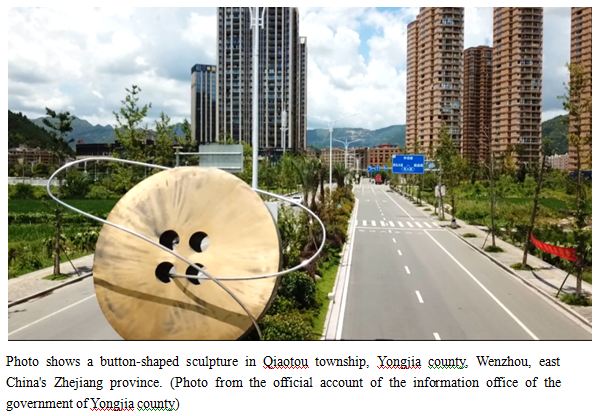By Chang Jin, People’s Daily
What is a luminous button? How is a pill-shaped button made? How do flame-resistance buttons work? The answers to these questions can all be found in Qiaotou township, Yongjia county, Wenzhou in east China’s Zhejiang province.
Home to a number of button manufacturers, the township produces over 50 billion pieces of buttons of more than 10,000 types on a yearly basis, which are exported to some 30 countries and regions abroad. More than half of the buttons on the Chinese market are manufactured in Qiaotou. That’s why the township is nicknamed the “capital of buttons” in China.
Buttons are inconspicuous, but indispensable to daily life.
In 1983, a button market was established in Qiaotou township, which is the earliest specialized rural market in China. In the following 40 years, button manufacturers in the township constantly upgraded their equipment and key technologies, developed new shapes and forms of buttons, and stepped up efforts to realize intensive, large-scale and green production of buttons.
Thanks to their endeavor and innovation, they have made “small buttons” into a big business.
As the development of the clothing market gets more individualized and higher-end, button manufacturers in Qiaotou have focused on the production of decorative buttons. They expanded investment in designing, strengthened their R&D teams and worked to improve manufacturing technologies.
The teams have introduced new techniques such as color printing, carving, laser engraving, and lacquer painting, and launched a series of new products including nacreous buttons, buttons with engraved patterns and metal buckles. These efforts have successively raised the added value of the merchandise they’re attached to.
Based on the button industry, a cluster of enterprises producing support materials such as zippers, ribbons and rickrack was established in Qiaotou township. Forming an export base of clothing accessories, they have constantly extended and improved the value of the garment industrial chain.
Striving to move toward the mid- and high-end of the button market, which is more eco-friendly, fashion and culture-oriented, button manufacturers in Qiaotou conform to the trend of consumption upgrading and have found new grounds for industrial development.
Qiaotou township has established an intellectual property alliance and applied for more than 400 patents. A chamber of commerce in the township invites experts to evaluate innovative technologies developed by local button manufacturers regularly and put the creations under protection.
Innovation is the source of strength for enterprises, and by protecting the rights of innovation, Qiaotou township is striving for sustainable development of the button industry.
Embracing the opportunities created by the rapid development of e-commerce, Qiaotou is building itself into an e-commerce hub. It has established a comprehensive modern park comprised of a premium market, e-commerce services, public innovation spaces and intelligent logistics.
The township is also developing influencer marketing and livestream commerce. As a result, it has seen a significant rise in both the trading volume and turnover of its products.
Today, more than 30 percent of the business in the button market of Qiaotou is completed online. A modern button manufacturing base that integrates production, development, marketing, information and services is taking shape in the township.
Turning from a manufacturing base to a marketplace, and integrating manufacturing and service sectors, Qiaotou has made stepped-up progress through digitalization and internet-assisted development.
This indicates that the integrated development of the digital economy and the real economy enjoys huge potential. Traditional industries can not only gain new advantages in competition, but also restructure the industrial ecosystem.
The story of Qiaotou township growing from a remote rural area to China’s No.1 button market is a witness to the innovative development of China’s clothing accessories.
Buttons were once considered a low-tech product, and there was even the term “button phenomenon” that was used to describe small, uncompetitive and poorly-managed manufacturers with low added value and low profit that could only serve as OEMs.
However, the clothing accessory industry today, represented by the button business, has improved its technologies and extended industrial chains through innovation, forging new advantages in competition. Qiaotou’s exploration of the button industry proves that traditional industries and enterprises can have a great transition if they quicken their steps in innovation, technological development and digitalization.



















